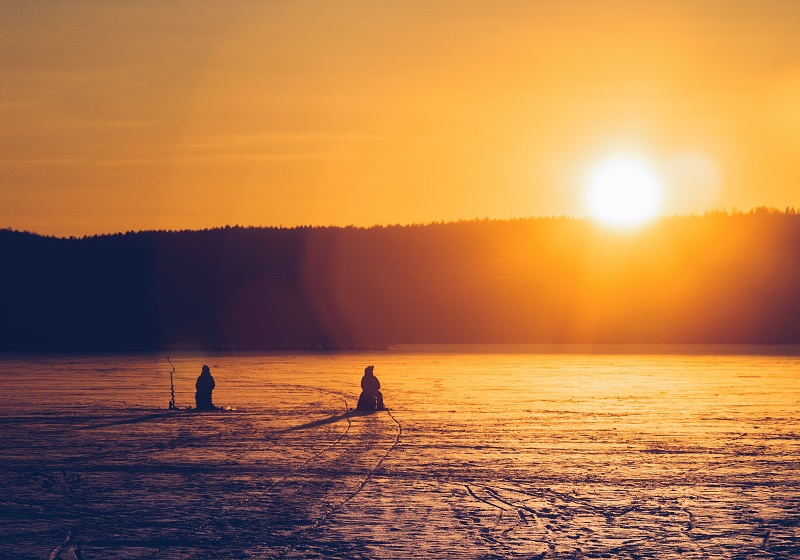
Catching bass during the winter can be difficult, especially for those who fish in the north and midwest. As temperatures drop and bodies of water start freezing, we anglers find ourselves in a situation where bass fishing becomes challenging. Aside from having the best fishing baits available, you will need to understand the behavior of bass and where they go during winter to catch them.
Bass fishing during the winter comes with great rewards as plenty of bass pack a powerful punch in the weight category. Many bass are fat during the winter from the fall feeding frenzy, and catching a biggin during winter makes it that much more fun. You will succeed in winter bass fishing with proper adjustments, the adaption of new fishing habits, and help from this bass fishing winter guide.
The Best Baits For Winter Bass Fishing
Understanding that the fish’s metabolism is at its lowest during this time of year lets us know that bass isn’t usually interested in larger baits. Their digestive system is at a point where it’s difficult for them to consume larger baits. Focus on baits with a smaller profile and slower action for more success in winter bass fishing. We recommend not exceeding a bait that weighs more than three-eights of an ounce in weight and four inches in length being the maximum.
Depending whether or not you have to break through ice will determine which bait to use. Here are three great options for you to try:
Soft-plastic bait fish for winter fishing
Baitfish is the foundation of a bass’s diet. This type of bait should be mimicked or used for winter bass fishing. The Dart is an excellent option for a baitfish presentation. Work this style of bait slowly, as baitfish also become lethargic during the winter, and you want the soft-plastic bait to be natural as possible.
Drop shot for winter bass fishing
The drop shot can be used all year round. Known for its success in deeper water, the drop shot is a perfect option for winter bass fishing as it allows you to reach appropriate depths where those bass are hanging out. The Drop Kick by Red Angle is a drop shot bait known for catching smallmouth and largemouth bass all year.
Smaller soft-plastic worms for winter bass fishing
Using a small soft-plastic worm with a quarter-ounce weight usually equates to a successful catch during winter. Popular for its look and action, The Dagger is a soft-plastic worm that’s ideal for catching bass during winter.
Additional options include a lipless crankbait and hair jig if your geographic location provides the right conditions.
Best Time of Day to Catch Winter Bass
Similar to summer bass fishing, winter bass fishing has its peak hours to be successful. Although fish can bite any time of day, it is best to focus on the afternoon hours during the winter. We have found the best results starting around 1:00 pm and leading up until the sun goes down. It’s believed that starting later gives enough time for the sun to warm the water enough to activate baitfish, which results in bass being more prone to move.
Although the afternoon is the best time, it’s not the only option. Smallmouth bass appears to favor earlier hours when the sun is coming up for the day. Depending if your favorite hatchery is known for spots, largemouth, or smallmouth bass, we recommend trying different times to see when the best feeding time is for you.
Where to Catch Bass in The Winter
Bass are widely known to hang out around cover where they feel safe. This includes vegetation, stumps, rock piles, and laydowns. If you can find some docks then we recommend attempting those as cover areas when searching for bass.
Water Depths For Winter Bass Fishing
Water depth is perhaps one of the most crucial elements when finding where to catch bass during winter. There is no specific depth for a one size fits all approach because each body of water has its own depth range. Try venturing out to areas where it is deeper and water clarity is good. This does not mean you have to be at the deepest part of the lake, but rather in an area where the lake is deep, and water temps are warm.
An awesome tip: The clearer the water, the deeper baitfish will be. The dirtier/darker the water, the shallower baitfish will be.
As previously mentioned, baitfish is the foundation of the bass diet, so it’s vital to understand where the baitfish are for winter bass fishing success.
Advice For Winter Bass Fishing
Keep your expectations realistic by understanding that bass bite less often compared to summer. Their metabolism has decreased, and they aren’t as hungry. Also, their breathing slows down, and they don’t move as often. According to Iowa State University, no other physical factors affect the development and growth of fish as much as water temperature.
You may receive just a handful of bites one day and a few dozen the next when bass fishing during the winter. It’s all about persistence and dedication to learning more about fish’s behavior. The reward is well worth it, as bass tend to be larger in the winter because of their eating habits leading up to this point.
Be sure that your bait selection reflects the metabolic rate of the fish and their energy levels. As much as we anglers would love to throw on a larger profiled lure and get bit within seconds, it just doesn’t happen this way during the winter.
Be mindful of the depth, water temperature, and water clarity for the best success. If you are located in the north or midwest region, the bite will be more challenging compared to those who live in the southern part of the country. Be patient and allow your expectations to be a guide for when you’re looking to be successful while catching bass during winter.
